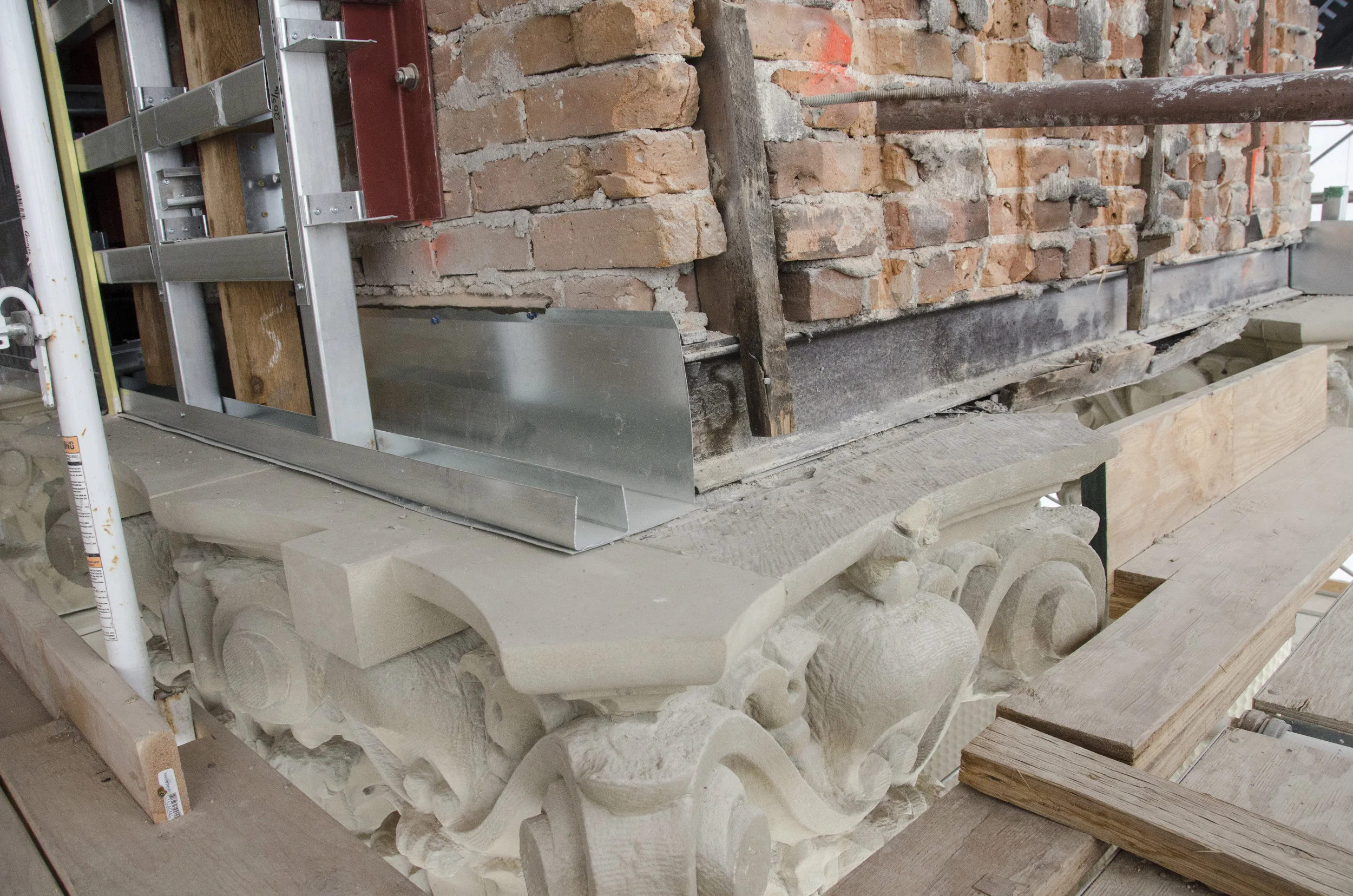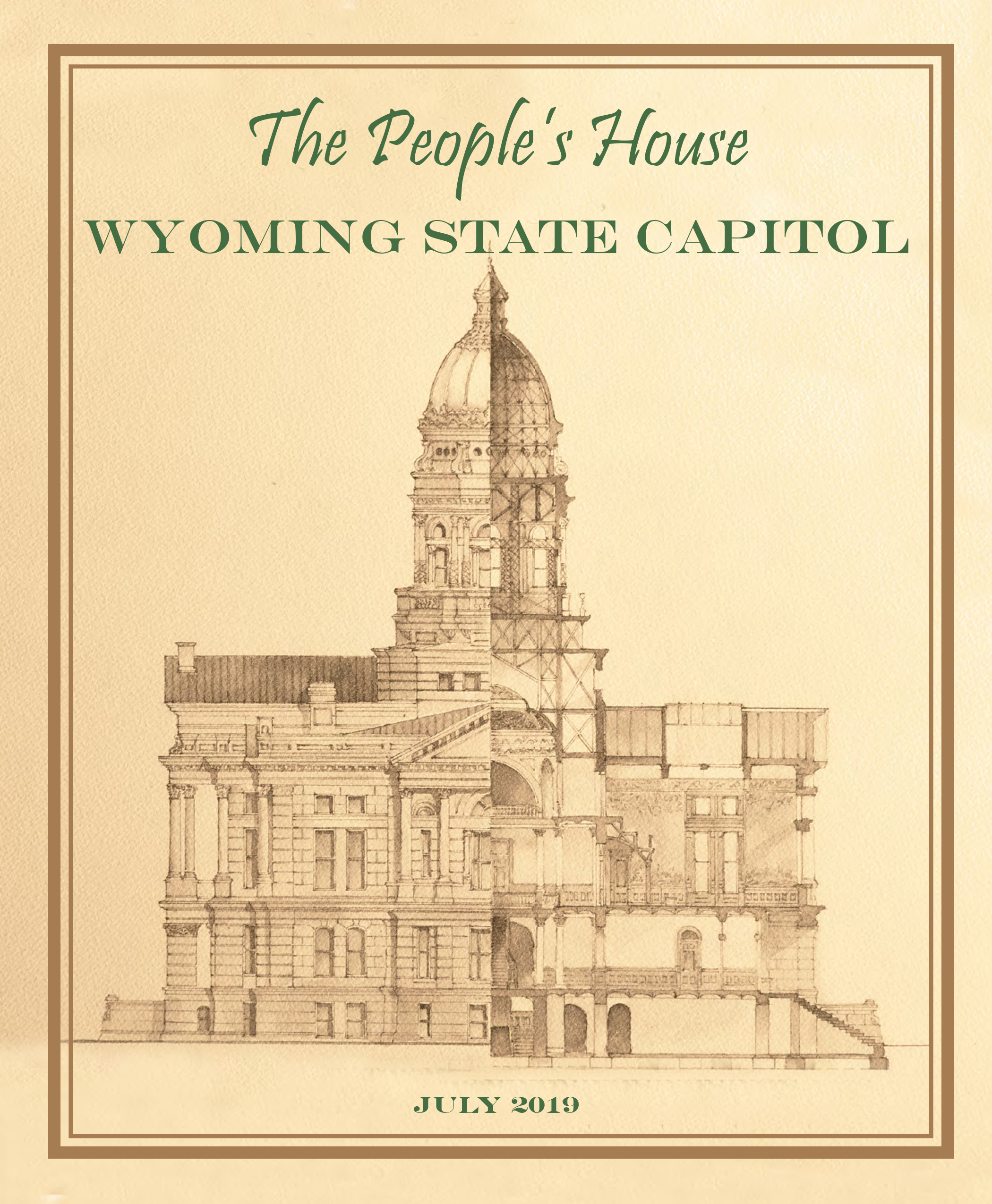Sandstone restoration efforts on the west wing of the Capitol
/Behind the scaffolding, restoration of the sandstone and metal entablature on the west wing of the Capitol is almost complete. In April, the scaffolding will be moved to cover the east wing of the building. On the west wing, the repaired and replaced stone will appear lighter in color and will weather over time to match the rest of the building.
On the exterior of the west wing, 195 stones have been replaced and 336 stones have been repaired.
A repaired piece of stone just below the entablature, above the third floor of the Capitol, is a lighter shade and smoother than its neighbor which is an original piece of stone. (Click on photos to make them larger.)
WHY STONE RESTORATION IS NEEDED
The masonry on the Capitol is well over 125-years-old. The first two courses of stone at the base of the building are an iron containing buff/pink sandstone from Fort Collins, Colorado. The remaining masonry walls from the base to the parapet are a gray sandstone quarried in Rawlins, Wyoming.
And, while the masonry is generally sound, some stones are damaged and loose, requiring replacement and repair. Cracks, spalls and voids, along with blistering, delamination, erosion, and discoloration have been identified. All the stone has been evaluated for restoration or replacement based on life safety issues, water and longevity management and aesthetic considerations. To maintain the historic look of the building and stay cost–effective, the project plans to only replace stone when necessary.
Many stone pieces came off the Capitol during the stone investigation process. Looking through the third floor window into the outside scaffolding, you can see a collection bag for stone removed from the exterior of the Capitol.
Some of the stone on the Capitol is a life safety hazard and must be repaired or replaced. This piece of loose stone, weighing about seven pounds, was at the top of one of the column's pilasters.
Here is an example of water damage, causing the sandstone to delaminate. Delamination is a when the outer surface of the stone splits apart into thin layers and peels off the face of the stone. This damage was likely caused from rising damp from the grounds and the landscape irrigation system. This photo also shows the buff/pink sandstone from Fort Collins, Colorado used as the base of the building versus the gray sandstone from Rawlins, Wyoming.
Water has damaged some of the sandstone. Here is an example of the sandstone deteriorating in layers, as well as an open joint where water is getting in and damaging inside and outside of the Capitol. Throughout the exterior, there are open and deteriorated mortar joints in the masonry. Repair includes cleaning out all the mortar joints and replacing with new mortar.
USE OF THE ORIGINAL SANDSTONE QUARRY
The sandstone for the Capitol restoration efforts was mined at a quarry near Rawlins, Wyoming. The majority of the original stone used the Capitol was mined at this quarry in the late 1880s.
Special thanks goes to the current quarry owner the Anschutz Corporation which has allowed the State of Wyoming to harvest the stone for free. "The Anschutz Corporation has been doing business in Wyoming for over 65 years and we are pleased to be able to contribute to the restoration of the State Capitol," said Bill Miller, Senior Vice President, The Anschutz Corporation.
The July 2, 1897 edition of the Rawlins Republican newspaper, called sandstone from the Rawlins quarries, owned at that time by James McPherson, as “the finest building stone in the West.” The newspaper also recognized the sandstone quarries’ importance to the commercial interests of the town. The Murray & McPherson Quarry, located just four miles southeast from Rawlins, supplied material for the Wyoming Capitol, the Wyoming State Penitentiary and other buildings in Nebraska and Colorado. About 20 cubic feet per day were removed from the stone ledges, placed on wagons and hauled to the Union Pacific Railroad tracks in Rawlins for transport. According to the May 11, 1889 issue of the Carbon County Journal, Murray & McPherson had a contract calling for 16,000 cubic feet of sandstone to be used in the completion of the Capitol.
The original quarry opened Sept. 1, 1887 by Robert Murray and James McPherson, both of whom served an apprenticeship in Scotland and had been quarrying rock for 25 years. According to the May 11, 1889 issue of the Carbon County Journal, the just over 40-acre quarry employed eight men, and in its first few years 120,000 cubic feet of stone or nearly 600 railcar loads had been shipped throughout the nation.
A rare photograph published in the July 2, 1897 issue of the Rawlins Republican showing the Rawlins quarry. The article noted that the “quarries are filled up with the most improved machinery, including two steam derricks, steam drills and electric appliances for splitting the stone into blocs of any dimensions desired.” When at full capacity, ten rail cars of stone a day could be removed from the quarry. The article is courtesy of the Wyoming Newspaper Project. (Click here to download the PDF page)
What made the quarry unique in the 1880s was that huge stone seams had little soil covering it. The Carbon County Journal article noted that the rock was 1,500 feet in length, 100 feet in width and 20 feet in height. Underneath this exposed ledge, there is another strata from 60-70 feet in depth and the same length and greater width than the top layer.
Miners pose in a sandstone quarry, owned by the Kerr Marble and Stone Company, near Rawlins between 1890 and 1910. The machinery includes a stiff leg derrick with crane, tripod drill, and boiler on a rail track. A quarry building is nearby. Despite the name, Kerr Marble & Stone Co., listed on the photo, we believe that this photo might be of the same quarry used in the Capitol restoration. Photo courtesy of The Denver Public Library, Western History Collection, X-61322.
One man poses on a slab of sandstone that is hoisted by a stiff leg derrick in a sandstone quarry, owned by the Kerr Marble and Stone Company, near Rawlins between 1890 and 1910. A quarry building is nearby. Despite the name, Kerr Marble & Stone Co., listed on the photo, we believe that this photo might be of the same quarry used in the Capitol restoration. Photo courtesy of The Denver Public Library, Western History Collection, X-61323.
The May 11, 1889 issue of the Carbon County Journal described the mining process as follows: “A line of the required length is cut by the picks along the front of the rock and on top of the depth of one or two inches of the required dimensions. Into this line iron wedges are gradually driven two or three inches, when the rocks splits with remarkable precision into the required size. About twenty cubic feet per day are torn from the ledges and hauled to the Union Pacific railway.”
In 2015, the State of Wyoming returned to the Rawlins quarry to remove sandstone from three small pits for the restoration of the Capitol. Although the quarry had closed many years ago, there was enough stone for the Capitol’s restoration efforts. About twice as much stone as needed was removed from the quarry to compensate for sandstone that might not be useable. By December 2015, semi-trailers hauled about 100 sections of stone, some five foot cubes while others were five by eight slabs, to Cheyenne to be stored outside to endure a winter freeze and thaw cycle. In the spring, fabricators cut the usable pieces of stone into much smaller pieces needed to replace damaged stone.
Remnants of the past mining efforts remained, including a shelter made of stacked blocks and holes chiseled in the stone.
The middle pit of the quarry in 2015.
Cuts were made in the sandstone where sections will be broken off.
Instead of pickaxes used in 1880s, the 2015 process used a diamond infused wire to cut through the sandstone. The wire is connected in a loop to the quarry saw, which then pulls the wire through the cuts.
The quarry saw is moved into place to start cutting stone. A bottom-horizontal cut is made first and then the vertical cuts are made.
These metal looking tablets are actually water bags. Workers will put a water bag in the cut and connect a high pressure washer to it. The bag will blow up to be five or six inches wide, pushing and separating the slab, allowing workers to tip it over. Once the slab is separated, then workers will cut off blocks which vary in size.
Here Eldon Strid, president of Cheyenne-based Strid Marble and Granite and onsite mining engineer, measured stone blocks, which were broken into roughly 5-foot cubes to 5 by 8 foot sections. Every stone block is uniquely identified. The stones are marked with the date that they were placed in the yard and where it came from. About 200 blocks were cut with roughly 100 being selected for the Capitol.
SELECTING REPLACEMENT STONE
Selecting the replacement stone started with a masonry review back in 2015. Workers removed 1 foot by 1 foot samples from the quarry to compare colors to the existing stone. Prior to restoration efforts, the Capitol stone had a patchwork look in which some areas had darker stone while other stone was much lighter. To match the existing look, the team selected stone in acceptable range of color. After the repairs are made when people look at the building, they will be able to see the repaired stone until the fresh blocks weather. As the sandstone ages, the repairs will blend in with the rest of the stone.
The first step was to wash a select portion of the exterior elevations to remove surface dirt without causing damage to the stone’s surface. In order to remove the surface dirt, an electric powered handheld pressure washer was used at low pressure to rinse the stone starting at the third level down to the base of the building using an aerial lift.
During the second step in the masonry review process, the project team reviewed the stone samples taken from the stone quarry against the existing stone on the building in multiple locations beginning at the upper portion of the elevation and working their way down. The stones gave the design team a real range of what is a good match in terms of granularity and colors.
Additionally, the design team compared the stone samples on top of one of the stone blocks at the quarry in Rawlins.
STONE REPAIR
On the west wing of the Capitol, workers have repaired the sandstone. The scaffolding has been covered with tarps to prevent silica being released into the air as the stone is being carved on site, as well as to protect the workers from the elements.
Replacement stone that is ready to be installed. Each piece is labeled, so workers know where to install it. This helps workers to match the existing stone on the building.
On the third floor level, stone masons have repaired this piece of decorative stone. The lighter color portion is the repaired stone.
On the third floor level, stone masons will carve the new piece of stone to match the original.
There were open and deteriorated mortar joints in the masonry. Restoration efforts for the entire exterior include cleaning out all the mortar joints and replacing with new mortar.
The new shiny metal entablature was put in place first while the replacement stone was completed. (Click on the photos to make them larger.)
A new piece of stone awaits being carved by the stone masons. Over the last several months, stone masons have carved and repaired stone behind the scaffolding.
The scaffolding and its cover will move to the east side of the building in April.







